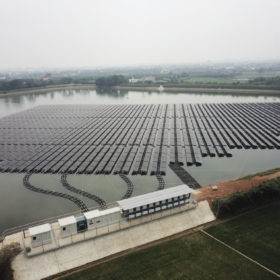New Siemens units lay marks in hydrogen generation, mobility and energy-as-a-service
With a flurry of recent announcements, the newly-launched power division of the electronics giant plans to drive hydrogen mobility in Germany and enter the commercial and industrial power market in the US.
Another bumper year sees green bonds push through $1tn mark
Sustainability-linked debt financing is experiencing ever increasing popularity and the success of green bonds has driven other products linked to social performance and other sustainability criteria. The total volume of such investments to date passed the $2 trillion point this year.
Floating PV paired with hydroelectric dams to cover peak load
A research team from Pakistan has modeled the addition of a floating PV array to an existing dam project to increase the availability of power during peak load hours.
Port of Rotterdam micro-market trial boosts battery storage returns 20%
A small-area trial of artificial intelligence and blockchain-based energy trading software demonstrated big improvements across all renewable energy performance metrics. The port authority now wants the system across all its premises.
EU wants lithium self-sufficiency by 2025
As the bloc pushes its digital and green transition agenda, policymakers have looked at the raw materials required. Little is mined, processed or assembled in Europe at present but the European Commission has a plan…
US and UK discover lithium as IHS Markit projects battery price to fall below $100/kWh
The business intelligence firm has projected storage costs will continue their downward trajectory on the back of product and process optimization. That will favor a higher adoption rate in automotive and grid applications, the analysts say. Elsewhere, discoveries of lithium in the U.S. and the U.K. have raised hopes for lower raw material costs and more supply chain diversity.
Chinese PV industry headed toward grid parity
Project delays and price changes due to fluctuating demand are disrupting the Chinese solar market. Researchers who have analyzed the situation claim that the nation’s PV industry will be back on track toward grid parity by the end of the year.
‘European cobalt supply hinges on circular economy’
Amid an uptake in EV sales, researchers are examining battery material supply chains. A report has indicated policy-driven circular economy strategies must be introduced in Europe if the bloc is to strengthen its resilience to volatility in the cobalt market.
Airbus charts path to zero emission aviation by 2035
At a press conference today, executives at the European airplane manufacturer explained how it will be possible to have market-ready zero-emission planes within 15 years.
Nextracker inks 1 GW supply deal and claims up to 12% bifacial yield gain
The 1 GW fifth phase of the Mohammed bin Rashid Al Maktoum Solar Park in Dubai will feature NX Horizon trackers with the deal announced after the manufacturer published new bifacial yield gain claims.










